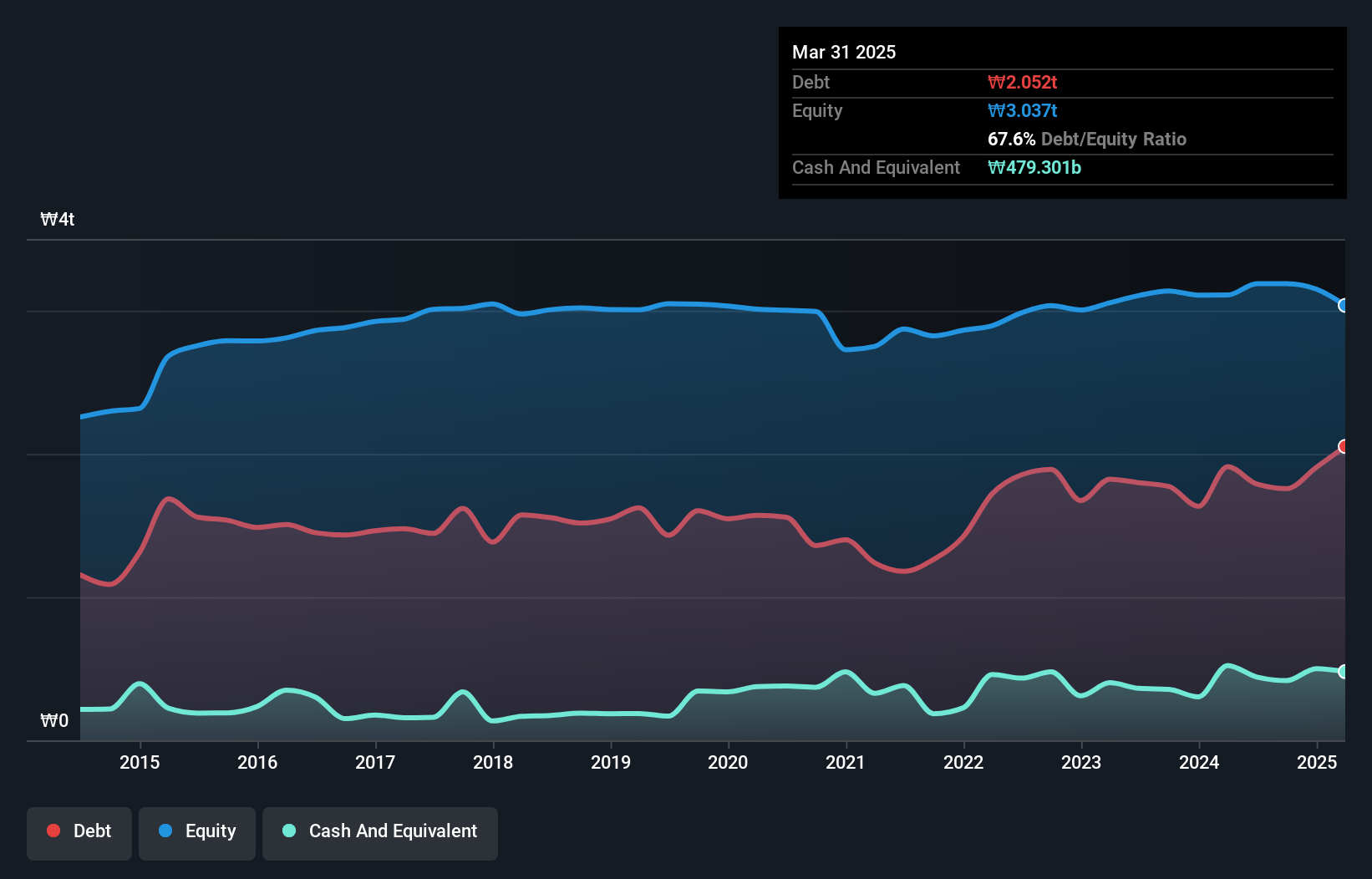- South Korea
- /
- Metals and Mining
- /
- KOSE:A058650
SeAH Holdings (KRX:058650) Seems To Be Using A Lot Of Debt
The external fund manager backed by Berkshire Hathaway's Charlie Munger, Li Lu, makes no bones about it when he says 'The biggest investment risk is not the volatility of prices, but whether you will suffer a permanent loss of capital.' So it might be obvious that you need to consider debt, when you think about how risky any given stock is, because too much debt can sink a company. We can see that SeAH Holdings Corporation (KRX:058650) does use debt in its business. But is this debt a concern to shareholders?
What Risk Does Debt Bring?
Debt and other liabilities become risky for a business when it cannot easily fulfill those obligations, either with free cash flow or by raising capital at an attractive price. In the worst case scenario, a company can go bankrupt if it cannot pay its creditors. However, a more common (but still painful) scenario is that it has to raise new equity capital at a low price, thus permanently diluting shareholders. Of course, plenty of companies use debt to fund growth, without any negative consequences. When we examine debt levels, we first consider both cash and debt levels, together.
What Is SeAH Holdings's Debt?
You can click the graphic below for the historical numbers, but it shows that as of March 2025 SeAH Holdings had ₩2.05t of debt, an increase on ₩1.91t, over one year. However, it does have ₩479.3b in cash offsetting this, leading to net debt of about ₩1.57t.

How Strong Is SeAH Holdings' Balance Sheet?
The latest balance sheet data shows that SeAH Holdings had liabilities of ₩2.19t due within a year, and liabilities of ₩1.02t falling due after that. On the other hand, it had cash of ₩479.3b and ₩928.1b worth of receivables due within a year. So its liabilities total ₩1.80t more than the combination of its cash and short-term receivables.
The deficiency here weighs heavily on the ₩425.1b company itself, as if a child were struggling under the weight of an enormous back-pack full of books, his sports gear, and a trumpet. So we definitely think shareholders need to watch this one closely. After all, SeAH Holdings would likely require a major re-capitalisation if it had to pay its creditors today.
Check out our latest analysis for SeAH Holdings
We measure a company's debt load relative to its earnings power by looking at its net debt divided by its earnings before interest, tax, depreciation, and amortization (EBITDA) and by calculating how easily its earnings before interest and tax (EBIT) cover its interest expense (interest cover). Thus we consider debt relative to earnings both with and without depreciation and amortization expenses.
Weak interest cover of 1.8 times and a disturbingly high net debt to EBITDA ratio of 6.3 hit our confidence in SeAH Holdings like a one-two punch to the gut. This means we'd consider it to have a heavy debt load. Even worse, SeAH Holdings saw its EBIT tank 36% over the last 12 months. If earnings continue to follow that trajectory, paying off that debt load will be harder than convincing us to run a marathon in the rain. The balance sheet is clearly the area to focus on when you are analysing debt. But it is SeAH Holdings's earnings that will influence how the balance sheet holds up in the future. So when considering debt, it's definitely worth looking at the earnings trend. Click here for an interactive snapshot.
But our final consideration is also important, because a company cannot pay debt with paper profits; it needs cold hard cash. So we clearly need to look at whether that EBIT is leading to corresponding free cash flow. Over the last three years, SeAH Holdings reported free cash flow worth 10% of its EBIT, which is really quite low. For us, cash conversion that low sparks a little paranoia about is ability to extinguish debt.

Our View
On the face of it, SeAH Holdings's EBIT growth rate left us tentative about the stock, and its level of total liabilities was no more enticing than the one empty restaurant on the busiest night of the year. And furthermore, its interest cover also fails to instill confidence. Considering all the factors previously mentioned, we think that SeAH Holdings really is carrying too much debt. To our minds, that means the stock is rather high risk, and probably one to avoid; but to each their own (investing) style. When analysing debt levels, the balance sheet is the obvious place to start. However, not all investment risk resides within the balance sheet - far from it. Be aware that SeAH Holdings is showing 4 warning signs in our investment analysis , and 1 of those can't be ignored...
If you're interested in investing in businesses that can grow profits without the burden of debt, then check out this free list of growing businesses that have net cash on the balance sheet.
New: Manage All Your Stock Portfolios in One Place
We've created the ultimate portfolio companion for stock investors, and it's free.
• Connect an unlimited number of Portfolios and see your total in one currency
• Be alerted to new Warning Signs or Risks via email or mobile
• Track the Fair Value of your stocks
Have feedback on this article? Concerned about the content? Get in touch with us directly. Alternatively, email editorial-team (at) simplywallst.com.
This article by Simply Wall St is general in nature. We provide commentary based on historical data and analyst forecasts only using an unbiased methodology and our articles are not intended to be financial advice. It does not constitute a recommendation to buy or sell any stock, and does not take account of your objectives, or your financial situation. We aim to bring you long-term focused analysis driven by fundamental data. Note that our analysis may not factor in the latest price-sensitive company announcements or qualitative material. Simply Wall St has no position in any stocks mentioned.
About KOSE:A058650
SeAH Holdings
Engages in the steel materials business in South Korea and internationally.
Slight risk and fair value.
Market Insights
Community Narratives



